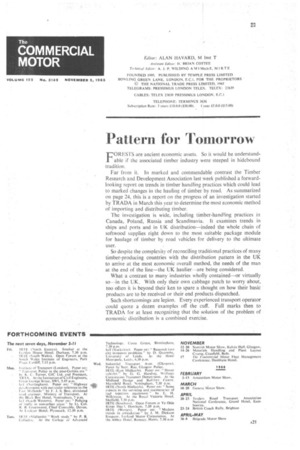Pattern for Tomorrow
Page 23

If you've noticed an error in this article please click here to report it so we can fix it.
UORESTS are ancient economic assets. So it would be understandable if the associated timber industry were steeped in hidebound tradition.
Far from it. In marked and commendable contrast the Timber Research and Development Association last week published a forwardlooking report on trends in timber handling practices which could lead to marked changes in the hauling of timber by road. As summarized on page 24, this is a report on the progress of an investigation started by TRADA in March this year to determine the most economic method of importing and distributing timber.
The investigation is wide, including timber-handling practices in Canada, Poland, Russia and Scandinavia. It examines trends in ships and ports and in UK distribution—indeed the whole chain of softwood supplies right down to the most suitable package module for haulage of timber by road vehicles for delivery to the ultimate user.
So despite the complexity of reconciling traditional practices of many timber-producing countries with the distribution pattern in the UK to arrive at the most economic overall method, the needs of the man at the end of the line—the UK haulier---are being considered.
What a contrast to many industries wholly contained—or virtually so--in the UK. With only their own cabbage patch to worry about, too often it is beyond their ken to spare a thought on how their basic products are to be received or their end products dispatched.
Such shortcomings are legion. Every experienced transport operator could quote a dozen examples off the cuff. Full marks then to TRADA for at least recognizing that the solution of the problem of economic distribution is a combined exercise.




















































































































